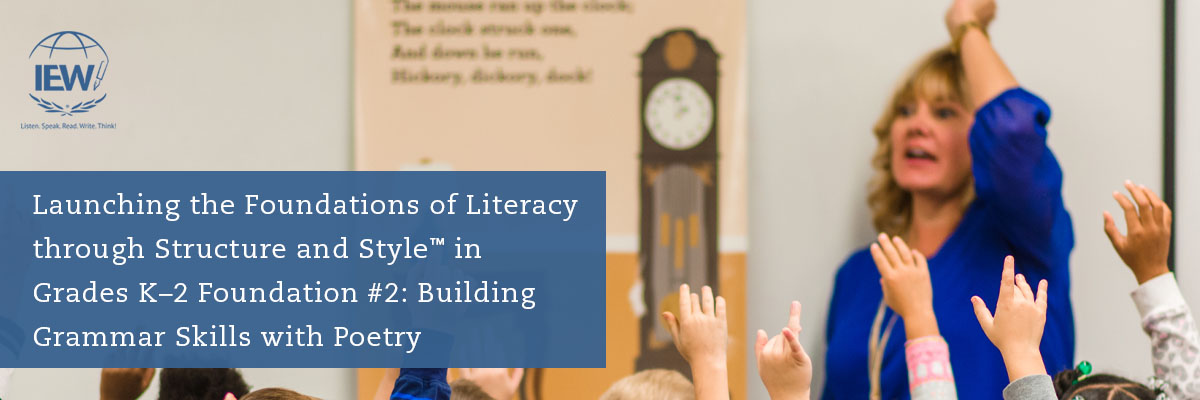
In Part 1 of this series on IEW’s primary materials, we discussed poetry as a powerful tool in language development, specifically in building language skills and boosting reading comprehension. Part 2 examines the way poetry lessons also teach grammar effectively—and enjoyably—to lay a strong foundation for a solid understanding of grammar before children move into the intermediate grades.
Most people would agree that good grammar is important, yet it undoubtedly tops the list of least favorite school subjects for many students and adults! Andrew Pudewa frequently mentions Why Johnny Can’t Write by Myra J. Linden and Arthur Whimbey in his seminars, talks, and podcasts. In the aptly named second chapter, Grammar: The Ineffectual Monster, the authors describe grammar as “a confusing maze leading to tears, tedium, and the total rejection of English classes” due primarily to the way it has always been taught—learning parts of speech and identifying them in sentences. Not only do these teaching methods not work, they may even have a harmful effect on improving writing (6).
From my own years of teaching, I can strongly attest to the futility of trying to teach grammar in these traditional ways. It didn’t work, and my students despised it. In my classroom, “Please take out your grammar books” would elicit great wails of despair as students collapsed melodramatically at their desks in utter anguish. These methods certainly would not have passed Dr. Webster's Two-Question Test (Does it work? Is it enjoyable?) as an effective teaching method, yet this is the way grammar continues to be taught in most classrooms from kindergarten through high school.
So, if these traditional methods don’t work, what do Linden and Whimbey recommend? “The best way to learn standard written English is the same way spoken language is learned, through usage and habit, not through formal grammar” (Linden and Whimbey 10). They are describing inherent grammar.
In IEW’s The Arts of Language Podcast, episode 228, “The Great Grammar Give and Take, Part 1”, Andrew Pudewa describes inherent, or inherited, grammar as
- the language database we develop as we grow up and live our lives
- the most important to attend to if we want students to speak and write well because the language that comes out of the brain will be dependent on the language that goes in
- a mission critical to developing competent and excellent communicators
- best developed in an environment that encourages children to speak, write, and use the wealth of linguistic marble they have been gifted with
This is the grammar that children bring with them to kindergarten. Some have been exposed to a language-rich environment at home; others have not. Many are limited English speakers.
In his popular talk “Nurturing Competent Communicators” and also in his introduction to Linguistic Development through Poetry Memorization, Andrew contends that the best way to add to the database in children’s brains of reliably correct and sophisticated language patterns is an abundance of reading aloud and poetry memorization.
Let’s take a closer look at how poetry is used to build and strengthen a child’s inherent grammar, using the poem “September” in the Week 3, Day 1 lesson in the Grade 1 Classroom Supplement and Lesson Plans.
- Present the poem using IEW’s Primary Posters on a smart board or projected with a document camera. Read it aloud with expression to the whole class.
- Discuss unfamiliar words. Ask: What is an aster? (a daisy-like flower that blooms in the late summer or fall) Add to the “Flower Word Bank” begun in Week 2.
- Chorally read the poem.
- Review nouns and find them in the poem. Circle the nouns. If you use a color system to indicate parts of speech, use your color choice.
- Find the color words in the poem. Discuss how the colors describe the nouns.
- Introduce adjectives as describing words. Find the adjectives in the poem. Draw a box around them. If you use a color system to indicate parts of speech, use your color choice.
- Choose a thing in the classroom, e.g., a desk or a flag. Guide students in describing the item with adjectives.
- Aster plants can grow from eight inches to eight feet tall! They are big plants. Create a Word Bank for synonyms of “big.” Ask, What part of speech is big?
In Day 2’s grammar lesson:
- Teach students the adjective test: The ____ pen.
- Practice using the test by creating a Word Bank for words that describe the grasshopper: The ____ grasshopper. (foolish, noisy, green, brown, happy)
- Add the adjective sticker to the Tools for Young Writers folder.
Repeat this activity on Day 3 by comparing the ant to the grasshopper:
- What size is the ant?
- Create a Word Bank for “little.” (tiny, teeny, miniscule, minute, etc.)
- Review the terms “synonym” and “antonym.”
These interactive discussions that spring organically from the poem and the word banks created together allow children to experiment and have fun with the words while simultaneously increasing their listening and speaking vocabulary. Remember, improving the way children speak improves the way they write! The word walls, word banks, and lists of synonyms naturally reinforce the parts of speech.
Poetry also shows students how sentences are built. Anna Ingham believed young children should be “immersed in an atmosphere which promotes good writing.” This would include frequent exposure to
(1) good literature and poetry with related dramatization and illustration (2) an awareness of sentence structure with emphasis on punctuation and comprehension and (3) a constantly expanding vocabulary. Finally children should be exposed to (4) an abundance of simple spelling rules and observation with no pressure administered but only an encouragement to take risks. Naturally many of these ingredients would occur simultaneously and will continue to the end of the year. Falling like raindrops off the umbrella, this nourishment should become part of the classroom atmosphere (Ingham 147). See this blog post about poetry.
Mrs. Ingham believed that primary students did not need to know grammatical terms such as “subject,” “verb” and “object,” but immersing them in this language-rich environment best prepares and guides the child for the “happy and effective participation in the world of written communication” (Ingham 147). No worksheet can do that!
Inspired by the methods of Anna Ingham, IEW’s Classroom Supplement and Lesson Plans for Kindergarten, Grade 1, and Grade 2 are filled with poetry and language-rich opportunities that immerse young children in the nourishing atmosphere that builds their inherent grammar and prepares them well for a lifetime of good writing and good grammar.
Are you ready to get started in your classroom or school?
Examine lesson materials.
To see a sample of our primary Classroom Supplements, including pacing charts and several weeks’ lessons, click on the links below.
Speak to an educational consultant.
If you would like more information about IEW’s training and classroom instructional materials for grades K–2, email Schools@IEW.com or call 800.856.5815 to speak to an Educational Consultant.
Other blog posts in this series:
Foundation 1: Language Development through Poetry
Foundation 3: Teaching Phonics through Poetry
Foundation 4: Facilitating Composition through Handwriting Instruction and Copy Work
Works Cited
Ingham, A.G. The Blended Sound-Sight Program of Learning, sixth ed. publisher,
2004.
Linden, Myra J., and Arthur Whimbey. Why Johnny Can't Write: How to Improve
Writing Skills. L. Erlbaum, 1990.
|
Jean brings 34 years of classroom experience to IEW, having taught grades 1–6 in New York, Virginia, and in California, where she taught sixth-grade language arts in the Rocklin Unified School District. She was introduced to IEW in 2001 when a colleague shared Student Writing Intensive videos at weekly school staff meetings. As a result of student progress and teacher enthusiasm at her school, RUSD brought Andrew Pudewa to Rocklin many times over the next several years to train district teachers, resulting in improved student writing and test scores district-wide. Named Rocklin’s “Elementary Teacher of the Year” in 2001, Jean was also included in the 2004 and 2005 editions of Who’s Who Among America’s Teachers. |

